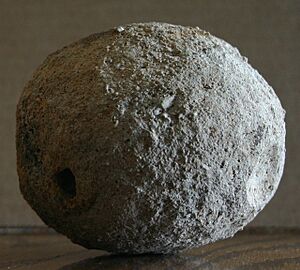Weaubleau structure facts for kids
The Weaubleau structure is a place in western Missouri that was likely hit by a meteorite. It is near the towns of Gerster, Iconium, Osceola, and Vista. Scientists believe a large meteoroid, about 1,200 feet wide, crashed here. This happened between 335 and 340 million years ago. That was during a time called the middle Mississippian Period. The Impact Field Studies Group lists it as a "probable" impact site.
This area shows signs of a huge impact. The ground was badly changed and broken up. For a long time, people didn't understand what caused it. They thought it might be from rocks pushing over a hill or a hidden explosion. But then, a geologist named Kevin R. Evans looked at digital maps of the land. He found a huge circular shape, about 12 miles across. This shape was hidden in the way the land was formed. It was first called the Weaubleau-Osceola structure. This was because of Weaubleau Creek and the town of Osceola. Now, it's just known as the Weaubleau structure.
A Well-Preserved Impact Site
Later, the site was covered by new layers of rock from the Pennsylvanian Period. This helped to protect the impact site. Only recently has some of it been uncovered by natural wearing away. Because of this, the structure is very well preserved. Scientists can also figure out its age quite accurately.
The Weaubleau structure is one of many known or suspected impact sites. These sites are found along the 38th parallel line. This line crosses the states of Illinois, Missouri, and Kansas. These impact sites are sometimes called the 38th parallel structures. Some scientists think they might have been caused by several impacts in a row. This would be like when Comet Shoemaker–Levy 9 hit Jupiter. But such an event is very rare for Earth. If other 38th parallel structures are found to be the same age as Weaubleau, it would make this idea stronger.
The Weaubleau structure is one of the fifty largest known impact craters on Earth. It is the fourth largest in the United States. The three larger ones in the U.S. are either buried under ice, under water, or have been changed by mountain building. This means the Weaubleau structure is the largest exposed impact crater in the U.S. that hasn't been greatly changed by Earth's movements.
Mysterious Round Rocks
In the area around the Weaubleau structure, you can find very round rocks. For a long time, people thought these were left behind by glaciers. These rocks are made of a mix of smaller rocks stuck together. Locals call them "geodes," "round rocks," "Missouri rock balls," or "Weaubleau eggs."
Some people think these round rocks are chert concretions or nodules. They might have formed when the impact threw pieces of shale rock far from the center of the crater. Then, water rich in silica (a type of mineral) hardened around these shale pieces. How these round rocks formed is still not fully understood. More research is needed to figure it out.




